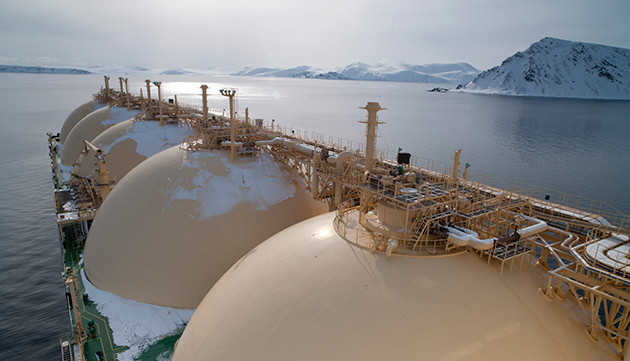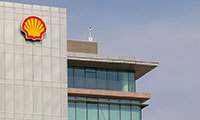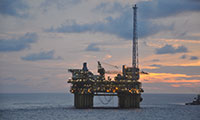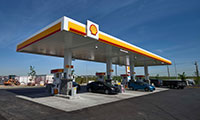LNG
Shell is involved in every stage of the LNG value chain. We find gas fields, extract and liquefy gas, trade and ship LNG, and turn it back into gas before distributing it to customers. Our acquisition of BG underscored Shell’s role as a leading independent producer and marketer of LNG.
Shell launched its second LNG Outlook in February 2018. Drawing on a broad range of independent industry data and internal analysis, the Outlook highlights key trends in 2017 and focuses on future global demand and supply (www.shell.com/lngoutlook).
The global LNG market continues to defy expectations, growing by 29 million tonnes in 2017, according to Shell's latest LNG Outlook. Based on current demand projections, Shell sees potential for a supply shortage developing in the mid-2020s, unless new LNG production project commitments are made soon.
The LNG Outlook finds that, since the start of the century, the number of countries importing LNG has quadrupled, while the number of countries supplying LNG has almost doubled. LNG trade increased from 100 million tonnes in 2000 to nearly 300 million tonnes in 2017.
LNG trade is changing to mirror the shifting needs of buyers, including shorter-term, lower-volume contracts with greater flexibility.
The LNG Outlook is designed to offer a balanced and informative outlook for LNG. It highlights the critical role of gas in the energy industry and in the transition to a low-carbon future.
Emerging LNG supply-demand gap
MTPA (DES)
Source: Shell interpretation of IHS Markit, Wood Mackenzie, FGE, BNEF and Poten & Partners Q4 2017 data
LNG liquefaction capacity additions
MTPA (FOB)
Source: Shell interpretation of IHS Markit Q4 2017 data, relating to assets under construction
Growing supply
In August 2017, QGC, in which Shell has a majority interest, started up the Charlie project: a development involving the construction of about 340 wells, a field compression station with a capacity of 240 terajoules a day, and associated pipelines and facilities that feed into existing gas-processing and water infrastructure at Woleebee Creek, South West Queensland, Australia. QGC supplies natural gas to the domestic market and LNG to international customers and can produce up to 8.5 mtpa of LNG.
Shell’s approach
We are the largest LNG marketer amongst all independent oil and gas companies (IOCs), with competitive positions in countries such as Japan, South Korea and China, but also in emerging LNG importing countries such as Malta and Jordan. At the other end of the chain, we are managing our supply portfolio for reliability and cost of supply. Through our joint ventures, we have the largest LNG liquefaction capacity among IOCs – with 13 plants – in all major supply basins.
We supplement this capacity with both long- and short-term third-party offtake contracts for additional flexibility and cost optimisation. In the middle of this value chain, we continuously optimise how we deliver LNG to our customers, depending on market conditions. We take advantage of the flexibility of our portfolio – our trading and optimisation capabilities – and our established position in shipping and regasification. Integration is not only a competitive advantage, it also makes us more resilient because we can capture value as it shifts to different parts of the LNG value chain.
Our approach includes:
- evolving our business models in mature markets and replicating them in new markets;
- securing valuable positions in priority growth markets;
- trading portfolio optimisation;
- growing downstream LNG fuel markets; and
- advocating for gas.
LNG customers
% total sales – geographic split
Create and secure demand
LNG for transport
The world needs cleaner vehicles and fuels to meet the increasing demand for transport with lower emissions. LNG is emerging as a cost-competitive and cleaner-burning fuel for shipping, heavy-duty road transport, and industrial applications. The International Energy Agency (IEA) estimates that use of LNG for transport could grow by as much as 14% between 2016 and 2022.
Shell has access to import and storage capacity at the GATE LNG terminal in the Netherlands, allowing us to supply LNG to marine and road transport customers in northwest Europe. To deliver LNG to customers in northwest Europe, in 2017, Shell took delivery of Cardissa, a state-of-the-art LNG bunker vessel able to hold around 6,500 cubic metres (m3) of LNG fuel. The vessel will deliver fuel from the GATE terminal in Rotterdam to customers across Europe.
In the USA, Shell finalised a similar agreement for an LNG bunker barge with the capacity to carry 4,000 m3 of LNG fuel. It is the first US-based ocean-going barge of its kind. It will supply LNG to marine customers along the southern East Coast and support growing cruise-line demand for LNG marine fuel.
In April 2017, Shell signed an agreement with Sovcomflot, a Russian shipping company, to supply LNG to four of its crude oil tankers. The oil tankers, which operate in the Baltic Sea and northern Europe, will be the first in the world powered by LNG. In February 2018, Shell signed a further agreement with Sovcomflot to time charter and fuel two of their tankers, demonstrating that LNG is being chosen in more segments of shipping to comply with the IMO's 2020 sulphur cap.
In December 2017, RedStar – a joint venture between Shell and Shaanxi Yanchang Group Company – opened an LNG retail site in Shaan’Xi, northwest China. China is the largest LNG for transport market in the world, with more than 200,000 trucks and buses using it.

LNG carrier Gemmata, pictured here, at anchor in Honningsvåg, Norway.
 Our businesses and organisation
Our businesses and organisation
 Financial data
Financial data
 Projects
Projects
 Outlook
Outlook